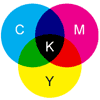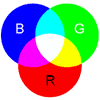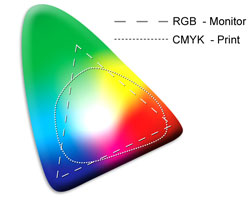Search by 'rgb' tag
-
RGB & CMYK
The two most common colour schemes are RGB and CMYK. An RGB colour scheme consists of three colours: Red, Green and Blue. These three colours are projections of light that can be overlapped in millions of colour-strengths and combinations to create on-screen colours and images. RGB colours are associated with television screens and computer monitors, but is not used in offset printing.

CMYKCMYK:
CMYK is made up of four colours: Cyan, Magenta, Yellow, and Black. In full-colour process printing, CMYK is the standard method for offset printing. In the printing process, CMYK colours are measured by their subtractive/ reflective values; when the coloured ink is applied to paper, the surface of the paper reflects some colour and the non-reflective (that is, absorbent) colour is seen. CMYK colours are obtained by mixing the strengths of each colour to produce a new colour. The colours are mixed in percentages: 0% represents no colour, whereas 100% represents a maximum use of colour.
RGBRGB:
The RGB colour process and the CMYK colour process work in opposite ways. An RGB colour scheme forms colour through an additive process; to obtain white, all 3 colours are added together, and to obtain black, all 3 colours are removed. In contrast, the CMYK printing process obtains white by omitting all colour, and obtains black by using all four colours. One of the major benefits of RGB colour is its capacity to produce many more colours than CMYK can. Unfortunately, RGB colours cannot be correctly converted into CMYK. People often find that a colour, especially a neon colour, created in RGB can"t be converted correctly into CMYK but instead appears as an "out of gamut" colour, which is usually dark and "muddy." To spot these colour errors, and to prevent printing nightmares, it"s imperative that all files are uploaded in CMYK format before any printing occurs. Color Spectrum:
Color Spectrum:
The CMYK process is not without its own drawbacks. One of the major difficulties of CMYK is its recognition of the colour blue. When blues are converted into CMYK, they have a tendency to print in purple. This is because blues are very closely related to purples in the CMYK colour scheme. To create a purple colour in CMYK, there are two variations of colour strengths: 80% cyan/90% magenta, and 100% cyan/100% magenta. To create a blue, very similar colour strengths are applied: 100% cyan/60% magenta. Because the creation of purple and the creation of blue are so similar, any small error that occurs while creating the document, taking it to pre-press, or printing it out, can change the colour from blue to purple. To prevent this colour change, we recommend that you reduce the amount of Magenta in your file to increase the likelihood that the colour will remain blue when printed.
CMYK also has difficulty with dark reds. When dark reds are converted and printed, they have a tendency to print as dark browns. Like blues and purples, dark reds and dark browns have similar colour percentages. Creating a dark red in CMYK requires 100% magenta/100% yellow/60% black. Creating a dark brown requires 70% magenta/100% yellow/80% black. To keep your dark reds from printing as dark browns, we recommend that you reduce the amount of Black in them.
